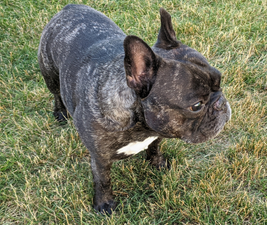This week Hope’s French Bulldog Torque was rejected, once again, for a commercial photo and film job. We’re convinced, despite a complete lack of evidence, that it was solely based on color. Because we know, with total conviction, that he is the handsomest, best-trained, most charming candidate available.
We don’t really want to hear how black dogs are hard to photograph. We want to bask in our high dudgeon that our beautiful boy has, once again, been the victim of color bias in dogs. And, aside from that, he’s not black, he’s brindle.
Dog colors define breeds
If there were no dog breeds, every dog on the planet would be a medium-sized, medium-brown, medium-snout example of dogginess. Fortunately, there are hundreds of breeds and some care about color. Others couldn’t care less.
Maltese breeders care. The standard reads “ pure white. Light tan or lemon on the ears is permissible, but not desirable.” We don’t think lemon on ears would be very comfortable, actually.
Which brings up the names that different breeds call their colors. The most unusual one we’ve heard is for Chesapeake Bay Retrievers. We know they’re not small dogs, but a friend of ours had one, so we found out more about them. Her dog’s color was called “deadgrass.” The lack of rain in our area has shown us exactly that shade all over the lawn. The breed standard says: “The color of the Chesapeake Bay Retriever must be as nearly that of its working surroundings as possible. Any color of brown, sedge or deadgrass is acceptable.” Okay, that makes sense. Camouflage dog!
Dog show memories
The color that had us stumped for years was in Cocker Spaniels. When we were little girls, Cockers were among the most popular dogs in the country. Our baby sitter’s family had one named “Skippy.” And wouldn’t you know, he was peanut-butter colored.
Anyway, our mom used to take us to dog shows when we were little. We couldn’t figure out what “ASCOB Cocker Spaniels” were. It was a separate category, but our little-girl brains didn’t get it. We were “Duh!” years older when we got the acronym: Any Solid Color Other than Black.
Some breeds don’t care at all
Every breed club defines the colors that are okay in their dogs. For many, the distinctive look is characteristic of the breed and they want to preserve that heritage. There are also genetic defects that can be linked to color, like white dogs with blue eyes often being deaf.
Some breeds are more easy-going about color. Chihuahuas are okay with whatever: “Any color – Solid, marked or splashed.” And Chinese Crested: “Any color or combination of colors.” So are Havanese: “All colors and marking patterns are permissible and are of equal merit.”
Want to get updates about dogs? Click here to sign up for the weekly newsletter!















